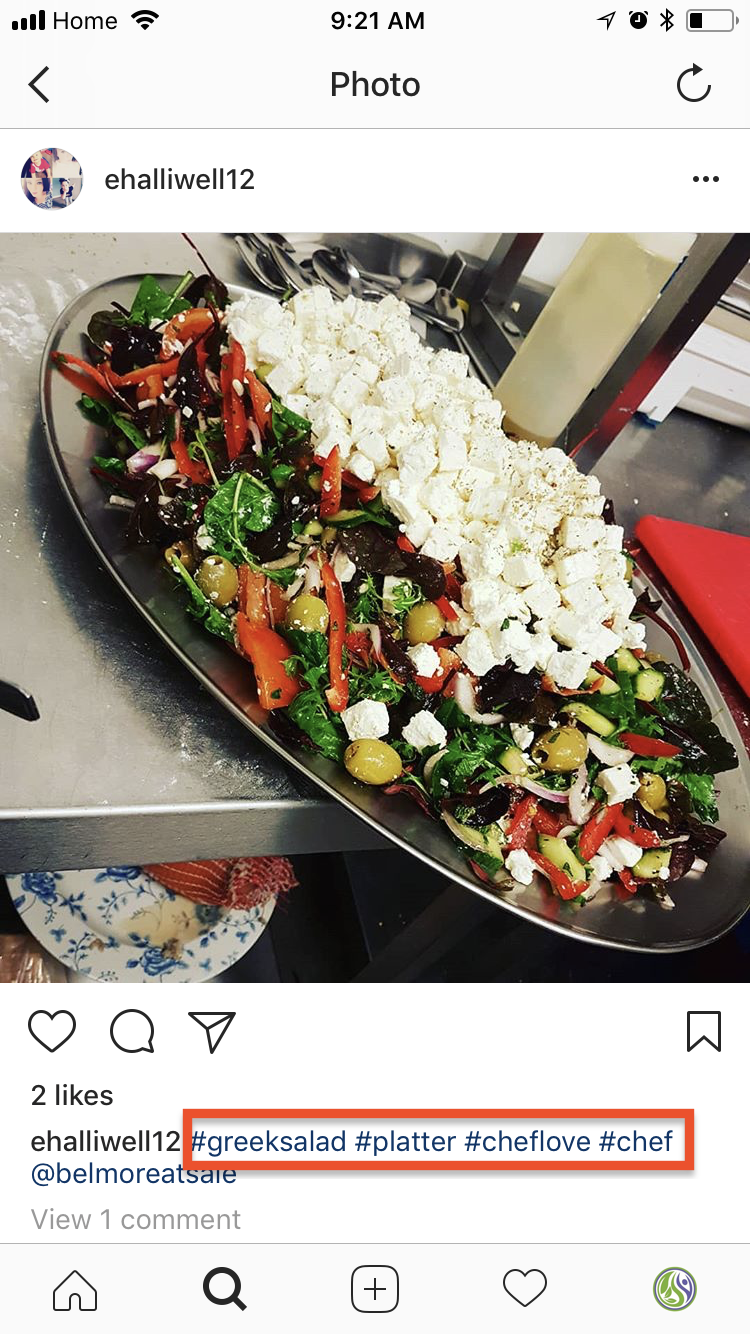With almost a third of all internet users on its platform, Instagram remains one of the best places to showcase your nutrition business in 2018.
But with more than 25 million businesses in the mix, how can you break through the noise and get found by your ideal clients?
In this article, we will help you find the ideal hashtag strategy for your nutrition business. This will bring you more engagement, more fans, and a unique change to grow your client base through social media.
In December of 2017, Instagram released an important update that allows you to follow Hashtags. These hashtags will now appear in your feed along with the accounts/people that you are already following.
This is a real game changer:
It means that by using the right hashtags, you can put your posts in front of an audience that doesn’t know about you yet but is already interested in what you have to provide as a practitioner.
 Step 1: Search and select a hashtag to follow.
Step 1: Search and select a hashtag to follow.
 Step 2: Follow the hashtag you selected.
Step 2: Follow the hashtag you selected.
 Step 3: See the hashtag you followed in your feed.
Step 3: See the hashtag you followed in your feed.
This organic traffic will bring you more likes, more comments, more followers, and more chances to convert these people into your nutrition business funnel.
In today’s article, we’re going to go over the hashtag strategy in detail and give you the tools to level up your Instagram game for business.
How Many Hashtags Should You Use?
Each Instagram post can contain up to 30 hashtags. The more popular the hashtag, the more people are using it and following it.
But if you choose to only use hashtags that are very popular (e.g. #love, #lol, #nutrition, etc…), your post will most likely be pushed out of sight by all the other posts that use this same popular hashtag.
What Hashtags Should You Select For Best Results?
To avoid getting pushed aside by the bigger Instagram accounts using common tags, you will need to organize your posts in a few different categories before you start picking hashtags.
This targeting will increase your chances of reaching the right audience on Instagram.
Step 1: Determine Your Post Categories
If your Instagram strategy is well laid-out, you should have at least 3-5 different post categories that you publish throughout the week.
These categories might include:
– Food pictures
– Recipes
– Inspirational quotes
– Motivational pictures with a long caption
– Promotional posts/special offers
– Humour
Each category should have its own set of tags so that it appears in front of the right people. (if someone follows the tag #quoteoftheday, they won’t necessarily be interested in seeing a picture of you latest smoothie bowl.)
Start by listing your post categories before moving onto the next step.
Step 2: Find 12 Hashtags For Each Post Category
For each category, you’ll need a list of tags that range from less popular to more popular to guarantee the most chances of getting found by new followers.
Note: a hashtag that has 100’000 posts will get about 200 posts per day. A hashtag with 10’000 posts will have about 20 posts per day. The fewer posts a hashtag has, the more chances you have of getting found. But on the flip side, less popular hashtags will have a smaller total audience following them.
As a starting point, I recommend you start with the following numbers as guidelines:
100K posts: 2 hashtags
50K – 100K posts: 3 hashtags
10K – 50K posts: 4 hashtags
1K – 10K posts: 3 hashtags
 Search for your category-specific hashtags along with their post count
Search for your category-specific hashtags along with their post count
Example for the recipe category:
#recipe 6m
#healthyrecipe 546k
#recipeideas 93k
#recipevideo 70k
#recipeblog 29k
#recipeidea 17k
#recipeinspo 13k
#recipeblogger 10k
#recipesharing 9k
#recipecreator 5k
#recipepost 4k
Follow this process for each category you listed in Step 1.
Now that you have your post-specific tags locked down, it’s time to find your brand-specific hashtags.
Step 3: Find 8 Tags Around Your Brand/Company Mission
This section can vary greatly from one nutrition business to the next. This is the best place to list the hashtags that will help you reach your niche audience.
If you’re not sure what to use, find 5-10 accounts that have the same niche as you and dig into their posts to see what tags they are using.
You can also include a branded hashtag that is specific to your company alone (we could use #holisticnutritionhub or #HNHCommunity).
For holistic nutritionists specialized in weight loss, the tags might be the following:
#weightloss 42m
#weightlosssupport 347k
#holisticnutritionist 60k
#weightlossideas 53k
#weightlossdiet 45k
#weightlossmission 53k
#weightlossrecipes 37k
#holisticapproach 15k
#nutritionforabetterlife 8k
Your brand-specific tags can be used in every post, combined with the right group of category-specific hashtags. Together, those give you 2/3 of the total tags and will already have a great impact on your Instagram success.
Your brand-specific tags can be used in every post, combined with the right group of category-specific #hashtags. Together, those give you 2/3 of the total tags and will already have a great impact on your #Instagram success. Share on XTo take it one step further, let’s find some tags that will help you target your audience geographically.
Step 4: Find 5 Geo-Specific Tags
If you work in person, these should target your town or general area. If you work online, the hashtags should correspond to the area where most of your potential clients live or post from. If someone searches that area specifically, they will be more likely to find your posts.
For someone practicing in Vancouver, BC tags might include the following:
#vancouver 14m
#vancouverfitness 130k
#vancouver_canada 36k
#vancouver_bc 20k
#yvrfit 4k
Step 5: Find 5 Post-Specific Hashtags
You might have noticed that with the numbers outlined in the strategy above, you still have 5 hashtags available.
Use those to describe precisely what your post is about (e.g. #greeksalad, #homemadesalad, #balsamicvinegardressing). These tags can be placed throughout your caption or at the end of it.
 Post-specific hashtags in the caption, courtesy of @ehalliwell12
Post-specific hashtags in the caption, courtesy of @ehalliwell12
Step 6: Combine Category, Brand, And Geo-Specific Tags In A Note
To complete this step, use your favorite mobile note app (iOS Note and Google Keep are great options). Each category will have its own note, with all three kinds of tags combined (category-specific, brand-specific, and geo-specific).
 Individual notes with combined tags for each category
Individual notes with combined tags for each category
When you publish your Instagram post, simply “select all” and “copy” the note that corresponds to that post’s category to get the right hashtags.
Step 7: Don’t Overload Your Caption!
To avoid clogging up the post description, use the first comment to add your 25 hashtags in.
Bonus: Boost Older Posts With Hashtags
You can “bump” older posts by adding hashtags to them (posting in the comments works fine).
This will bring them back to the top of the list and give them a second life!
Use This Hashtag Strategy To Get Your Nutrition Business Found On Instagram
Hashtag research will take you some time upfront but will turn your future posts into traffic magnets if done right.
[convertkit form=5172187]
Use this strategy to boost your Instagram engagement and increase your chances of being found by the public!
Question: how much engagement are you generating with this updated hashtag strategy? Compare your new, hashtag-optimized posts to your older ones and share your growth results in the comments below!
Sean is the co-founder of the Hub, a dedicated Personal Trainer and an Entrepreneur at heart. Passionate about all thing nutrition and fitness, he takes care of the HNH website, the community, and most of the laundry around the house. In his spare time, Sean loves building websites and writing about all things fitness, business, and marketing.


